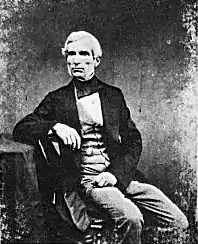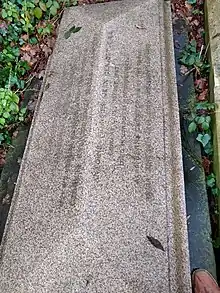Antoine Claudet
Antoine François Jean Claudet (August 18, 1797 – December 27, 1867) was a French photographer and artist active in London who produced daguerreotypes.



Early Years
Claudet was born in La Croix-Rousse, France, the son of Claude Claudet, a cloth merchant and Etiennette Julie Montagnat.[1][2]
Career
Early in his career Claudet headed a glass factory at Choisy-le-Roi, Paris, together with Georges Bontemps, and moved to England to promote the factory with a shop in High Holborn, London. Having acquired a share in L. J. M. Daguerre's invention, he became one of England's first commercial photographers using the daguerreotype process for portraiture, improving the sensitizing process by using chlorine (instead of bromine) in addition to iodine, thus gaining greater rapidity of action.[3]
He invented the red darkroom safelight, and it was he who suggested the idea of using a series of photographs to create the illusion of movement. The idea of using painted backdrops has also been attributed to him.
From 1841 to 1851 he operated a studio on the roof of the Adelaide Gallery (now the Nuffield Centre), behind St. Martin's in the Fields church, London, where in 1843 he took one of only two surviving photographs of Ada Lovelace. He opened additional studios at the Colosseum, Regent's Park (1847–1851) and in 1851 he moved his entire business to 107 Regent Street, where he established what he called a "Temple to Photography."[4]
It has been estimated that he made 1,800 pictures every year with subjects including Michael Faraday and Charles Babbage.[5] His daguerreotype of Hemi Pomara, in the National Library of Australia, is the oldest known photograph of any Māori person.[6][7]
In 1848 he produced the photographometer, an instrument designed to measure the intensity of photogenic rays; and in 1849 he brought out the focimeter, for securing a perfect focus in photographic portraiture.[3][8]
He was elected a fellow of the Royal Society in 1853, and in 1858 he produced the stereomonoscope, in reply to a challenge from Sir David Brewster.[3]
Claudet received many honours, among which was the appointment, in 1853, as "Photographer-in-ordinary" to Queen Victoria, and the award, ten years later, of an honor from Napoleon III of France.
Family and death
Antoine and Julia Claudet had eight children, the youngest of whom was Francis George Claudet (1837–1906) who became a noted amateur photographer in Canada.[9]
Antoine Claudet died in London in 1867 and is buried in Highgate Cemetery. Less than a month after his death, his "Temple to photography" was burnt down, and most of his valuable photographs were lost.[10]
References
- http://authorities.loc.gov/webvoy.htm Anglo-American Name Authority File, s.v. "Claudet, A.", LC Control Number nr 88000067, cited 10 February 2006
- http://www.getty.edu/vow/ULANFullDisplay?find=Claudet%2C+Antoine&role=&nation=&prev_page=1&subjectid=500024177 Union List of Artists Names, s.v. "Claudet, Antoine", cited 10 February 2006
- One or more of the preceding sentences incorporates text from a publication now in the public domain: Chisholm, Hugh, ed. (1911). "Claudet, Antoine François Jean". Encyclopædia Britannica. Vol. 6 (11th ed.). Cambridge University Press. p. 463.
- Monteiro, Stephen (2008-10-01). "Veiling the Mechanical Eye: Antoine Claudet and the Spectacle of Photography in Victorian London". 19: Interdisciplinary Studies in the Long Nineteenth Century (7). doi:10.16995/ntn.485. ISSN 1755-1560.
- "Only known photographs of Ada Lovelace in Bodleian Display". Bodleian Libraries blog. 2015. Retrieved 10 October 2017.
- deCourcy, Elisa; Jolly, Martyn (1 July 2020). "How we uncovered the oldest surviving photograph of a Māori person". The Spinoff. Retrieved 1 July 2020.
- Roy, Eleanor Ainge (30 June 2020). "Oldest surviving photograph of Māori discovered in Australia". The Guardian. Retrieved 1 July 2020.
- Brothers, A. (1899). Photography: Its History, Processes, Apparatus, and Materials: Comprising Working Details of All the More Important Methods. C. Griffin, limited. p. 225. Retrieved 2017-08-20.
- Mattison, David (2013). Encyclopedia of Nineteenth Century Photography. Taylor & Francis. pp. 304–5. ISBN 9781135873271. Retrieved 20 April 2021.
- A brief biography of Antoine Claudet. cartage.org.lb.